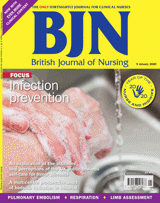References
Effective hand hygiene—wash your hands and reduce the risk
Abstract
Hand hygiene is considered one of the most effective ways of reducing healthcare-associated infections (Gould et al, 2017). Worldwide, thousands of people die every day from infections acquired while receiving healthcare, and as many as 1.4 million patients around the world develop a healthcare-associated infection each year. Many of these infections can be prevented by good hand hygiene (Luangasanatip et al, 2015). Hand hygiene can be performed either with soap and water or with alcohol hand rubs, which are now widely available in all healthcare settings (Royal College of Nursing (RCN), 2019). Hand hygiene should be performed at the five ‘moments’ identified by the World Health Organization (WHO) (2009a): before touching a patient, before clean or aseptic procedures, after body fluid exposure, after touching a patient and after touching patient surroundings. Alcohol hand rubs can be used but if your hands are visibly dirty, washing with soap and water is the preferred method (WHO, 2009a)
Register now to continue reading
Thank you for visiting British Journal of Nursing and reading some of our peer-reviewed resources for nurses. To read more, please register today. You’ll enjoy the following great benefits:
What's included
-
Limited access to clinical or professional articles
-
Unlimited access to the latest news, blogs and video content

